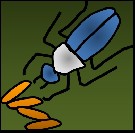Defoliators
The damage caused by leaf defoliators usually concern fragments on leaf edges and tips, but in some cases, the leaves can be cut off. When the plant is already grown, such damage is usually without great economic importance. However, when such infestations take place in the early development of the plant (until mid-tillering), they may harm a great part of the plant and lead to irretrievable losses.
One of the most widespread species is Nymphula depunctalis. It is a small (10–12 mm) pearly-white butterfly that lays its eggs in tight rows along the leaves. The larva crawls on a leaf and cuts it crosswise a few millimeters from its end, leaving only a tiny part connected to the remainder of the leaf. Because of the lack of turgescency , the leaf fragment wraps itself around the caterpillar, which then closes the part of the leaf that is almost cut off with a few silk threads, cuts the part that is still attached to the remainder of the leaf, and falls into the water. It is then well protected and can move on the water, with only the upper part of its body out of the leaf. It can then easily swim from rice stem to rice stem, climb up and feed. During the larva stage, it will change its protecting leaf many times. Drying the field for at least 3 days is an efficient method of control.
Other species of defoliators are: Cnaphalocrosis medinalis, Marasmia trapezalis, Diacrisia scortilla, Parnara spp., Hispides spp.













